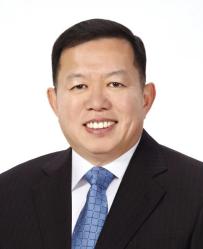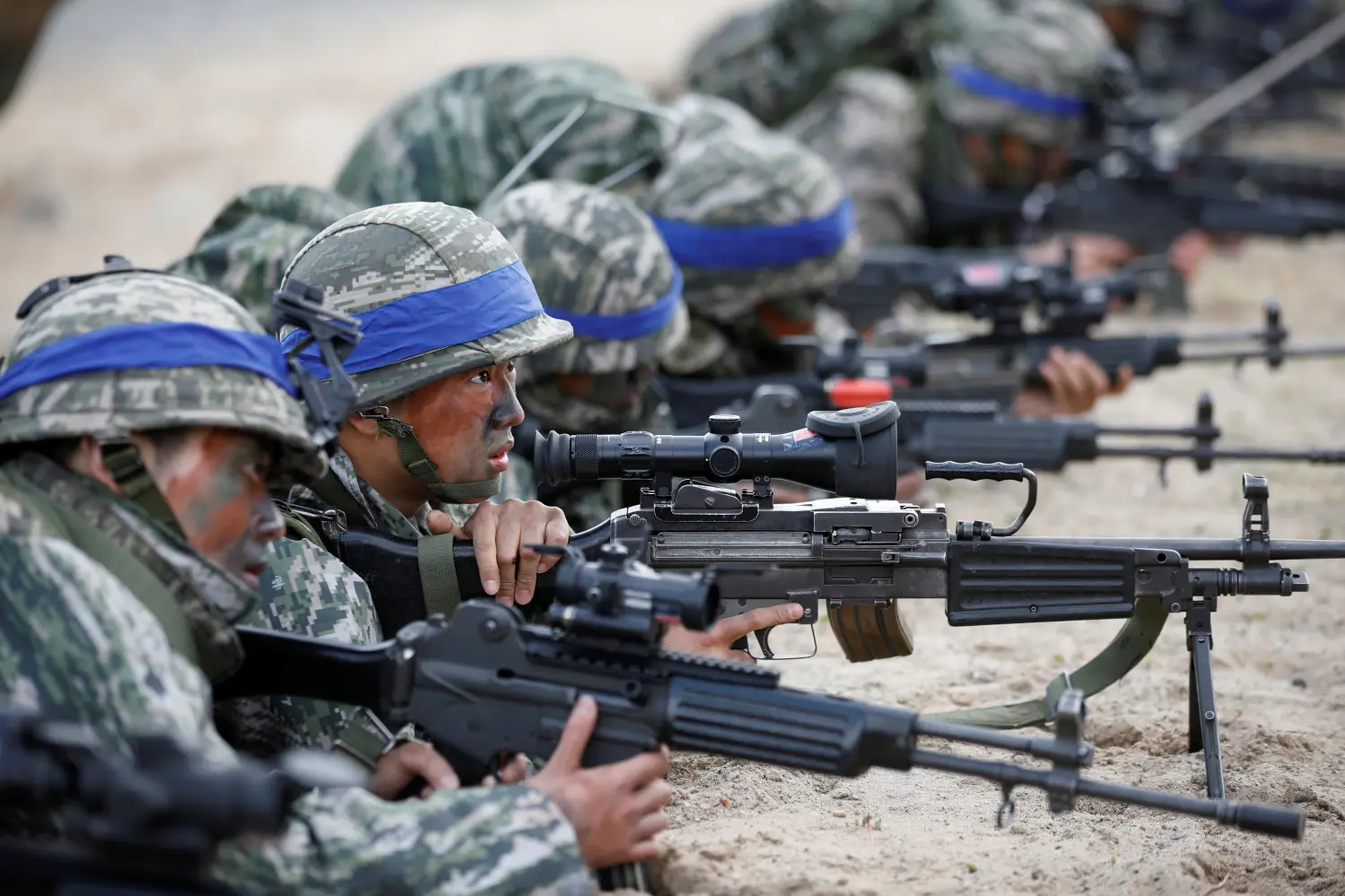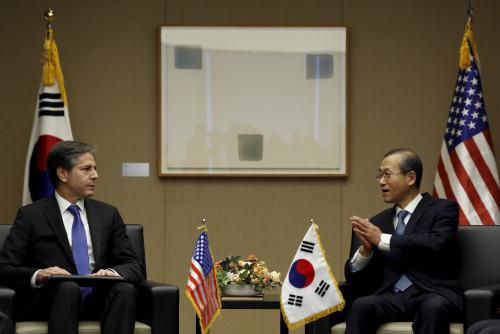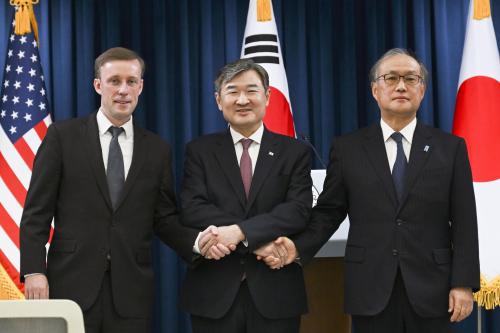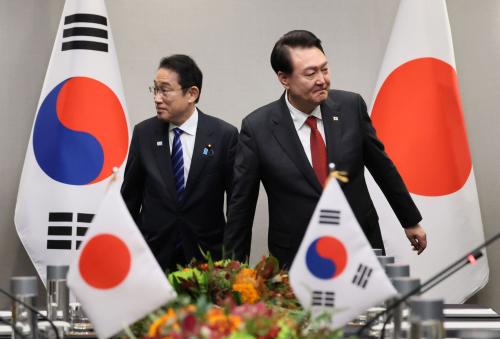Militaries typically engage in defense reforms based on several factors, including changes in threats, domestic affairs, new technologies, innovative strategies, leadership views, and cases of failure. Of all these factors, failure unfortunately tends to be the predominant driver behind most military reforms. From the mid-1950s until the 1990s, the armed forces of the Republic of Korea (ROK) focused on military modernization, particularly in obtaining, fielding, and sustaining modern weapons. In 1990, the ROK shifted from its emphasis on modernization to reforms centered on training, leadership, and research and development. The debate over military reforms continues to this day, indicating that reform efforts up to now have not yielded sufficient results. This paper examines ROK military reform efforts through its target objectives and challenges, and seeks to evaluate the efficacy of such reforms by using the teaching of Sun Tzu.
Background and history
The ROK armed forces were born in the days following the end of World War II when South Korea was striving to create a democracy. The United States assisted the newly-formed ROK in establishing a constabulary force on January 15, 1946, as the new nation’s military force. Less than five years after its inception, the ROK’s fledgling military found itself fighting for the survival of its new nation on June 25, 1950, when North Korean troops crossed the 38th parallel to invade South Korea. Unlike the ROK military, which had been denied heavy weapons and large-scale combat training by the United States, the North Korean military had clearly received extensive training and equipment from the Soviet Union. With the signing of the armistice that ended large-scale combat operations between the United Nations Command, North Korea, and China, the ROK military began to focus on modernizing its armed forces.
Following the armistice agreement, the United States provided intensive material support, training, and guidance to the ROK military until the late 1960s and continued thereafter as an alliance partner to further enhance the ROK’s military capability. In the 1970s, the U.S. withdrew some of its forces from South Korea, prompting deep concerns in Seoul that led to efforts in developing an independent, or self-reliant, national defense capability (jaju gookbang).1 During its formative years, the Korean military mirrored the U.S. military in terms of organization, training, doctrine, and operational procedure. On the other hand, much of daily life was dominated by old Japanese disciplines. At the same time, political and social developments, including a nascent move toward democracy, served as additional drivers for military modernization and the beginnings of military reform.
President Park Chung-hee (1963-79) initiated reform efforts in the indigenous production of small arms, which saw the birth of the Yulgok program. These efforts began because of the growing political friction with the United States and the withdrawal of U.S. forces from South Korea. Moreover, the downfall of the U.S. effort in Vietnam led to greater thinking about an indigenous nuclear program for Korea. Such efforts resulted in the ROK establishing the Agency for Defense Development (ADD) in August 1970.2 But after the assassination of Park Chung-hee, President Chun Doo-hwan shifted the focus to strengthening ROK-U.S. cooperation in defensive capabilities, along with political and economic reforms.
Roh Tae-woo’s administration (1988-93) proposed the 818 Plan in 1990 that distinguished and codified the roles and responsibilities between the ROK Joint Chiefs of Staff (JCS) and armed services. The ROK JCS assumed armistice operational command and control of ROK forces, while the individual services maintained administrative and training authority to promote generals and flag officers.3
The ostensible reason behind the 818 Plan may have been to create conditions for the transfer of operational control, but the main rationale behind the plan was to form a unified, joint command structure and move away from the tri-service organization of ground, air, and naval operations.4 However, resistance from the navy and air force led to the adoption of an interim framework under a “chairman ROK JCS (CRJCS) controlled command.” Those against this arrangement argued that joint operations do not require a unified command and that many nations had achieved joint operations under a tri-service arrangement. In other words, the sister services of the army advocated “teamwork” amid fears that they would become “spare parts” to the army with no real expertise in air and naval operations.5
Ultimately, while the 818 Plan did provide a much more capable ROK JCS, many were skeptical and suspicious about the administration’s intent.6 One significant aspect of this plan was the division of command and administrative authorities. Up until this time, the chief of staff of the army (CSA) had the sole power to command troops and only answered to the president. With the reform, the CSA transferred the command authority to the ROK JCS, under the direction of the president, and retained its administrative authority to promote and assign personnel.
21st Century defense reform
In 2005, President Roh Moo-hyun (2003-08) initiated the Defense Reform 2020 (DR 2020) plan focusing on a smaller, more technologically advanced force balanced across the services and under civilian control. DR 2020 also incorporated efforts to recruit more women into the ranks, as well as to increase the overall professionalism of the armed forces. The plan also consolidated the training and education of non-commissioned officers (NCO) and officers.
DR 2020 envisioned a more capable South Korea in the face of a rising China and a normalized Japan, thus aiming for a balanced force capable of operations in all domains—land, air and sea. For the ROK military, this represented a significant departure from what had historically been a land-centric military. Taking into account South Korea’s low birthrate, DR 2020 planned to reduce the total number of troops from about 650,000 to an end state of 500,000 troops by 2020. In order to reach this goal, the ROK would gradually reduce troop levels to 560,000 by 2015 and reduce the duration of mandatory service from 24 to 18 months. Correspondingly, by 2020, the plan sought to change the composition of all armed forces with 74.2 percent comprised by the army, 8.2 percent from the navy, 4.6 percent filled by the marine corps, and 13 percent by the air force. Volunteer careerists, as opposed to conscripts, were to form 40 percent of the total armed forces by 2020 as well. In addition, the ROK would increase the number of women in uniform by 1.3 percent for officers and 1.2 percent for NCOs.
Additionally, the plan included measures to improve reserve forces with new equipment and increased training. The plan also delegated coastal security duties to the police to better enable the military to focus on its core tasks. Other initiatives involved improving joint operation capabilities by strengthening the responsibilities of the ROK JCS and enhancing the role of civilian control. Hence, the ROK government planned to staff 70 percent of positions at the Ministry of National Defense (MND) with civilians, marking a 50 percent increase. The ROK also began to consider security issues beyond the peninsula by establishing a blue water navy and creating a standing Peacekeeping Operations (PKO) unit dedicated to peacekeeping operations mandated by the United Nations.
The army would be leaner but meaner, whereas the navy and air force would enhance offensive capabilities. Despite losing 170,000 men under the plan, the army would become more mobile and lethal. The frontline army headquarters would be combined into a single ground operations command. The navy would increase its capability to strike and provide surveillance for “all waters” operations with the establishment of a submarine and naval aviation command. The ROK marines would have the capability to conduct a brigade-sized landing (2,000-3,000 men). Meanwhile, reserves would decrease its troop size to about 1.5 million from 3 million, but with better training and equipment. The air force established the Northern Command and developed its “high-low mix” concept, which aimed to maintain 400 high-performance aircraft and 500 low-performance aircraft. The air force also planned to acquire capabilities for air refueling and air command and control.
The retention of wartime operational control (OPCON) of delegated Korean forces became a critical issue between South Korea and the United States. This resulted in an agreement to transfer OPCON in 2012, the dissolution of the ROK/U.S. Combined Forces Command (ROKUS CFC), and the establishment of a Combined Future Command, where a U.S. four-star deputy commander will support a Korean four-star commander.
During the Lee Myung-bak administration (2008-13), the National Assembly’s defense committee made a motion to return to utilizing alliance capabilities, implying that greater priority be placed on strengthening the ROK-U.S. alliance rather than the transfer of OPCON. In turn, it reduced defense spending from a 5-year plan of 621 trillion won to 599 trillion won (roughly a reduction from $552 billion to $532 billion) with significant impacts on procurement. The motion also delayed the reduction of the armed forces and placed no priority on developing a more global force to address regional powers like China. Furthermore, Lee and Obama agreed in 2011 that OPCON transfer should be delayed to 2015. And while DR 2020 had planned to gradually reduce the mandatory service duration to 18 months, the Lee administration stopped the reduction at 21 months.
After North Korea attacked the ROK navy corvette Cheonan in 2010, the Lee administration devised Defense Reform Plan 307 (DR 307) in 2011. The core component of this plan was to change the highest echelon of the command and control chain, namely the ROK JCS. DR 307 laid out a total of 73 tasks, and three timeframes to achieve these objectives: near-term (2011-12), mid-term (2013-15), and long-term (2016-30). DR 307 continued toward the goal of a 500,000-man army, but otherwise focused on adjustments to the authority of the ROK JCS chairman (CRJCS). Contrary to the separation of command and administrative control under Plan 818, DR 307 enhanced the authority of the CRJCS by granting limited administrative authority in the form of personnel management, logistical support, and training in support of the CRJCS’s ability to control the tri-services. Each of the service chiefs were to command operational forces: ground, air, and naval with an operational support command providing education/training, organizational, and logistical support. The composition of the ROK JCS would maintain a 2:1:1 ratio of army, navy, and air force personnel at key posts in order to keep a tri-service balance at the joint level. By 2020, the goal was to reduce the number of flag/general officers by 15 percent from 430 to 370 officers.
Not too long after the Cheonan incident, North Korea’s shelling of Yeonpyeong Island prompted the ROK to establish the North West Island Defense Command that would be commanded by the ROK marine corps, which could now call in joint assets in case of a contingency.
DR 307 also improved and integrated defense education and training. A prominent issue among service members was their lack of understanding on the reason for fighting. Bearing this in mind, DR 307 established the Defense Education Center and initiated cross-education programs at the tri-service academies to enhance their joint understanding and with the goal of eventually combining the institutions in the future.
The most important element of DR 307 was the re-prioritization of force improvements. Unlike DR 2020’s plan to prepare Korea for future challenges, DR 307 focused on the immediate threat from North Korea. These efforts included improved anti-submarine warfare (ASW) capabilities, counter-artillery measures, capabilities to combat North Korean weapons of mass destruction (WMD), and acquiring next generation capabilities like the fighter program (F-X) and early deployment of the global hawk.
Administrative reforms included more women in the armed forces, along with more cross-service opportunities and inter-service exchange programs. Veteran soldiers with hands-on experience were placed in frontline positions and the MND expanded the number of professionals, such as lawyers and specialists, working in the ministry.
Lastly, DR 307 designed plans to counter North Korean special forces and cyber threats by establishing units and procuring equipment specifically tailored for these missions. The ROK cyber command was established to counter the cyber threat from North Korea with plans to recruit over 100 cyber soldiers. It also activated special anti-terrorist units and added 38 Apache helicopters to the ROK arsenal.
By and large, the primary constraints that have impeded the full implementation of ROK military reforms are issues pertaining to the debate about the validity of a unified command, the transfer of operational control from the United States to South Korea, and the change in presidential administrations that unnecessarily prolongs the debate.
In 2013 under President Park Geun-hye, OPCON transition changed from a fixed date to a “conditions-based” arrangement. In other words, the transfer will only take place when certain conditions are met such as improved C4ISR (command, control, communications, computers, intelligence, surveillance, and reconnaissance), expanded munitions, and capabilities to counter North Korean nuclear and missile threats.7 Concepts such as the Kill Chain initiative and the Korea Massive Punishment and Retaliation (KMPR) program were developed to counter the ever-increasing North Korean nuclear and missile threats.
The Moon administration’s “Defense reform 2.0”
On July 19, 2017, the Moon Jae-in administration announced its plans to reform the Korean armed forces. The so-called “Defense Reform 2.0,” implying that it is an improved version of Defense Reform 2020, designates five focus areas:
- Strengthen counter-asymmetric capabilities to include the nuclear threat from North Korea;
- Early return of wartime operational control based on a strong ROK-U.S. alliance;
- Strong drive toward civilian control of military affairs;
- Eliminate defense acquisition-related fraud and foster a defense industry in accordance with the fourth-generation industrial revolution;
- Marked improvement of addressing human rights issues and service conditions for soldiers.
A special committee for defense reform will oversee these initiatives, which includes a reorganization of the higher command for a balanced growth of the tri-services and integration of warfighting capabilities. Under the plan, the duration of the universal draft will be reduced to 18 months from its current 21 months, as originally planned in DR 2020. Areas in acquisition, weapon systems, morale and welfare, and defense management are also mentioned in the reform plan.
The Moon administration has goals to complete the development of a three-pronged strategy to counter the North Korean threat by 2020: Kill Chain, Korea Air, and Missile Defense (KAMD), and Korea Massive Punishment and Retaliation (KMPR).8 A new three-star level command, referred to as the Strategic Command, is being considered to conduct such operations.9 By doing so, the Moon administration believes it will have set the conditions for the transfer of wartime OPCON and assuming the lead role in the defense of the peninsula with U.S. forces in support.
Assessing successes and failures
Critics have accused administrations of reforming the ROK military into a land-centric force and that DR 307’s overemphasis on joint capabilities was unnecessary considering that DR 2020 had already strengthened joint warfighting capabilities.10 The rest of this paper will look at Sun Tzu’s The Art of War in order to assess the successes and failures of ROK military reforms thus far.
The first chapter in The Art of War starts with detailed assessment and planning (Chinese: 始計) which explores the five fundamental factors (do [道] the way, cheon [天] seasons, chi [地] terrain, cheng [將] leadership, and beub [法] management) and seven elements that determine the outcomes of military engagements. By examining and comparing these points with ROK reforms, we can assess the chances of a military plan’s success or failure.
Do [道] the way
“Do” is the willingness of the people to follow the vision of the sovereign. In modern terms, it is a sense of legitimacy and an understanding of the issues under a commonly shared goal. Sun Tzu stressed that this was the most important and fundamental element to success.
Reforms usually arise from a failure to meet expectations or from new advancements in science, tactics, or technology. In the case of Korea, defense reforms started out with a recognition that all of the above had changed and that the Korean military needed to adapt to these developments. The commander-in-chief of the ROK armed forces, Roh Tae-woo, directed Plan 818 to create a unified and joint command that would be more cost effective and efficient. Yet, political suspicion, service rivalries and a general lack of interest and understanding by the public hampered these changes.11
For the past 30 years, this central challenge has not abated. In fact, resistance has become more critical from civilians and politicians who misunderstand the plan’s priorities and problems without realizing the perils of conformity. Compounding this challenge is the complacency of the South Korean public toward the North Korean threat. In sum, without a grasp of the real dangers and problems by South Korean society, ROK leaders cannot build consensus or mold public opinion toward a meaningful change.
Cheon [天] seasons; Chi [地] terrain
During Sun Tzu’s time, these two elements were essential for a nation’s military. Modern warfare today has produced far more available information and data on these factors, such that we focus less on these dimensions. Therefore, we can assess these factors from a perspective of dealing with modern intelligence challenges. Perhaps the modern day equivalent is the matter of command, control, communications, computers, and intelligence (C4I), which has become increasingly more critical in modern warfare. In spite of the ROK military’s awareness of its own shortfalls in these areas, sufficient focus and resources remain elusive. This may stem from the desire to obtain big-ticket weapons systems, such as fighter aircraft, while giving short shrift to more mundane items like computer terminals. The challenge for the ROK government and military is coming to terms with the fact that you cannot hit what you don’t know or what you cannot locate. Further, you cannot conduct effective strikes unless commanders have real time communications abilities with linked networks across its field forces.
Cheng [將] leadership
“Cheng” was considered by Sun Tzu to be a crucial element for success. Sun Tzu stressed that a great general should have knowledge above all other traits, along with faith, character, courage, and rigor. Korea’s military leadership is plagued by regionalism, favoritism, lack of appreciation for NCOs, overemphasis on academic achievements, and a ranking system and environment that hinders genuine camaraderie. Despite strict controls that are in place, the hierarchical nature of Korean society causes hazing incidents that lead to disciplinary issues. Overall, the ROK military culture lacks harmonious cohesion and none of the plans address this issue in detail. Although initiatives to de-emphasize academics and combine the tri-service academies have been discussed and welcomed, the urgency of these issues is not truly realized and is often overlooked.
Beub [法] management
The “beub” factor, as described by Sun Tzu, includes organization, communications, sustainment, and administration. Comparing this with the Korean case, this analysis will look at organization, C4I, training, equipment, and sustainment.
Organization
This is a key area for reform as matters of efficiency are pushed aside by politics and service rivalries. Compromises between the services have impeded a true joint command and although joint operations capabilities have indeed improved over the years, there is certainly room for more improvement. Another issue related to organization and mission command is OPCON.
Command, control, communications, computers, and intelligence (C4I)
OPCON has developed into an issue misunderstood by both the public and government, and also manipulated by North Korea. It has now been falsely embedded in the Korean mind that the U.S. government controls Korean forces. At the combined level, despite some improvements, communication issues such as language and cultural challenges have always been present, as the habitual common use system remains problematic. While a common joint system does exist, it is not truly joint in practice. Even at the operational and tactical level, C4I is disjointed and separated by independent systems. The real problem lies in the fact that C4I is still not fully recognized as a weapon system and not a subject of reforms.
Training
Training has been taken for granted and neglected. Outperforming ships and aircraft have produced the illusion that there is a high level of basic training when in reality, the Korean military, especially the conscript army, is ill-trained, and most army troops are spending the majority of their time on administrative tasks: cleaning, maintenance, and manual labor. There is an added liability risk associated with training troops, because realistic training can and will lead to accidents and fatalities at times. If a society like that of South Korea puts excessive scrutiny on each incident, the natural reaction from the public would be to train less. In this regard, the ROK air force and navy are better suited for training with machine-related activities, along with the fact that they have a small percentage of volunteer conscripts. The problem lies with the army, which comprises the majority of ROK forces.
Equipment
The ROK has fallen into the pitfall of expensive and high-tech weaponry, with F-15Ks and F-16s patrolling the air, aegis destroyers and submarines providing maritime security, and ballistic and cruise missiles built to strike North Korean targets. However, there are infantry platoons that still lack medium machine guns in their arsenal. Most South Koreans are quick to think “fraud and waste” when military equipment is discussed and do not consider whether troops have appropriate equipment in the first place. Soldiers still lack basic equipment needs including night vision goggles, GPS, radios, first aid kits, body armor, sights, and lasers. Nevertheless, the emphasis so far has only been on air, sea, and ground mobility, and strike capability.
Sustainment
Discussions surrounding efforts to sustain the ROK military’s manpower have been minimal at best. Initial manpower cuts were made to military logisticians, and not to the combat and support units. This is a common and foolish mistake made by many militaries that have failed to win wars. Plans to provide better and more efficient equipment were promised, but when the budget did not meet projections, the first things to be cut were trucks and lift equipment. Instead, the ROK military has relied on the “magic solution” of outsourcing and mobilization. A military can only win its battles if it is sufficiently trained, equipped, and fed, but ROK defense reforms fail to list such measures as a priority.
Conclusion
Since the Moon administration announced its initial plans for defense reform, North Korea has conducted more nuclear weapons and missile tests, including a possible thermonuclear device in September 2017. Although anticipated, this significant increase in tension will affect Moon’s plans for defense reform. Despite the South Korean government’s statement that no reintroduction of U.S. nuclear assets is being considered, over 60 percent of the South Korean public want a stronger deterrent in the form of U.S. tactical nuclear weapons on South Korean soil or an outright South Korean nuclear weapons program.12 Regardless of how this debate ends, it will undoubtedly affect the content and timing of Defense Reform 2.0.
ROK defense reforms began with the goal of having a capable and efficient deterrent against security threats and to prepare for the eventual change of the United States’ military presence in Korea. But from the outset, political suspicion and service rivalries came before this goal. The focus then shifted slowly to a more political aspect related to greater civilian control, OPCON transition, fraud and waste prevention for procurement, and human rights. These of course will contribute to a better overall security force, but should not be the primary focus of reforms from a strictly military perspective. Defense reform for the ROK must start with the goal of improving security. The risk-averse attitude of the ROK is a major problem for training the country’s military. It is not just a military issue, but a social, cultural, and political issue that can only be resolved politically. In order to do so, we must first recognize the fact that we have a problem at hand.
It is imperative that the ROK military stick to the basics. Even if the military was equipped with a F-15 fighter jet and a capable pilot, operations will still be at jeopardy without basic security. Only time will tell what will become of Moon’s Defense Reform 2.0.
-
Footnotes
- Kim Dal-Jung, South Korea’s Foreign Policy [Han-kuk-eui-wei-gyo-jung-chaek] (Seoul: Orm, 1998), 37.
- Seo Jung-wook, “Establishment of Agency for Defense Development,” Korea Economic Daily, September 2, 1996, http://news.hankyung.com/article/1996090203241.
- “Reduction plan of USFK troops prompts reorganization of military” Yonhap News Agency, May 10, 1990, http://news.naver.com/main/read.nhn?mode=LSD&mid=sec&sid1=102&oid=001&aid=0003437291
- Kwon Young-geun, Studies on Changing and Unchanging Parts of ROK Defense Reforms [Han-kuk-gun-guk-bang-gae-hyeog-eui-byeon-hwa-wa-ji-sok] (Seoul: Yeonkyung, 2013), 251-52.
- “[Defense Reforms] Chapter 4 on Plan 818,” July 5, 2017, http://blog.naver.com/cto_hwangga/221044289867.
- Ibid.
- “Conditions-based transfer of wartime operational control,” ROK Joint Chiefs of Staff, http://www.mndcic.mil.kr/mbshome/mbs/jcs2/subview.jsp?id=jcs2_020402010000.
- Jun Ji-hye, “3 military systems to counter N. Korea: Kill Chain, KAMD, KMPR,” Korea Times, November 1, 2016, http://www.koreatimes.co.kr/www/news/nation/2016/12/205_217259.html.
- Park Seong-jin, “[100 Administrative tasks for the Government] Defense Reform 2.0 Reform Drive…OPCON Transfer Timeline changed to ‘early return’,” Kyunghyang Shinmun, July 19, 2017, http://news.khan.co.kr/kh_news/khan_art_view.html?artid=201707191421001&code=910302#csidxae7461929084e4d9b1b2f8a52682c28.
- Kwon, Studies on Changing and Unchanging Parts of ROK Defense Reforms.
- Kim Jong-dae, “History of past defense reform failures (1) Roh Tae-woo’s 818 Defense reform plan,” Hankyoreh, June 10, 2011, http://plug.hani.co.kr/dndfocus/17852.
- Michelle Ye Hee Lee, “More than ever, South Koreans want their own nuclear weapons,” The Washington Post, September 13, 2017, https://www.washingtonpost.com/news/worldviews/wp/2017/09/13/most-south-koreans-dont-think-the-north-will-start-a-war-but-they-still-want-their-own-nuclear-weapons/?utm_term=.300bf026f7fc.
